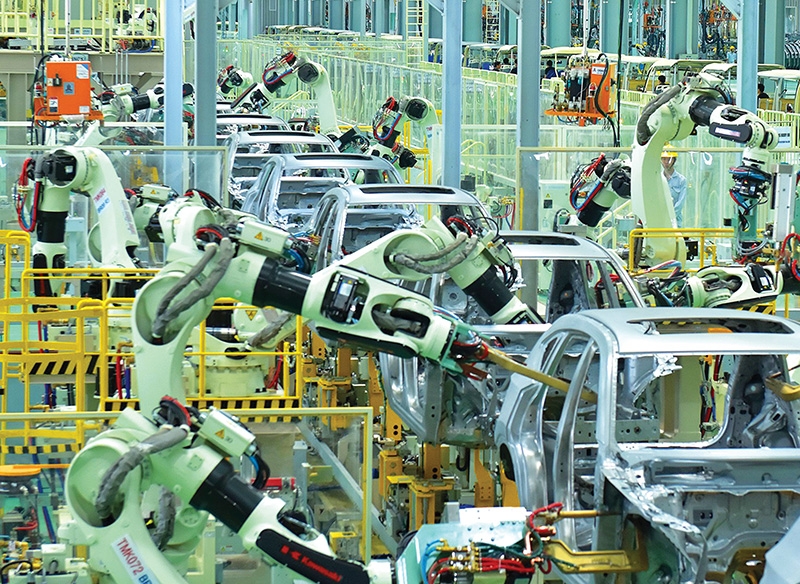Regional leaders work towards strong recovery
 |
| The Master Plan on ASEAN Connectivity 2025 will strengthen regional supply chains, Photo: Le Toan |
The ASEAN member states aim to foster regional trade ties by implementing a series of activities, including further opening markets in order to ensure food security and strengthening resilience and sustainability of the regional supply chain, nonuse of new non-tariff measures, building up foundations for intra-bloc trade facilitation to support supply chain connectivity, and utilising digital technology and commerce to support firms.
Once the activities are implemented, Vietnam’s trade ties with other regional nations will likely improve. In the first half of 2020, Vietnam’s total two-way trade with regional nations hit $25.3 million, with the country suffering from a $3.1 billion trade deficit. Vietnam’s export turnover from ASEAN member states was $11.1 billion, down 14.2 per cent on-year, and the country’s import turnover hit $14.2 billion, down 11.9 per cent on-year. The ASEAN is Vietnam’s fourth-largest export market and third-largest import market.
As ASEAN chair for 2020, Vietnam is co-ordinating with regional nations to boost smart production and develop 5G ecosystems and a roadmap towards no roaming charges, or at least as low as domestic charges.
In order to boost ASEAN economic recovery, member states established the COVID-19 ASEAN Response Fund to address the pandemic and future public health emergencies, along with the Regional Reserve of Medical Supplies to enable rapid responses to emergency medical supply needs with the support of external partners.
“These activities will help Vietnam earn higher credit in the region, and help the whole region’s economy bounce back,” said Prime Minister Nguyen Xuan Phuc.
According to the World Bank’s fresh forecasts for baseline growth in 2020 for many regional nations, Vietnam is expected to sit on top at 4 per cent. Meanwhile Cambodia’s growth rate is estimated to be at 2.5 per cent, the Philippines’ at 3 per cent, Indonesia’s at 2 per cent, that of Laos at 3.6 per cent, of Malaysia at -0.1 per cent, of Myanmar at 3 per cent, and that of Thailand at -3 per cent. Baseline growth refers to a scenario of severe growth slowdown followed by a strong recovery.
In order to implement the ASEAN economic recovery scheme, the bloc’s leaders have tasked the ASEAN Community Councils to undertake relevant works in their respective pillars to contribute to a comprehensive recovery plan, with the support of the ASEAN Secretariat and the ASEAN Co-ordinating Council, along the line of a whole-of-ASEAN community approach, to be submitted to the 37th ASEAN Summit for the leader’s guidance and instructions.
Since the beginning of the year, the ASEAN community has continuously held online conferences with the participation of all related ministries and agencies to implement timely actions against the pandemic.
“The ASEAN’s health emergencies response network and co-operation with partners were activated from the very first days. All ASEAN countries have engaged in active information and experience sharing, and co-ordination in disease control,” PM Phuc said.
According to Minister of Trade and Industry Tran Tuan Anh, all member states have been aiming to keep the ASEAN market open for trade and investment, strengthen regional information sharing, and collaboration in responding to the economic challenges, as well as worked with industry stakeholders to instil confidence in Southeast Asia as a trade, investment, and tourism hub.
The bloc wishes to boost the implementation of the Master Plan on ASEAN Connectivity 2025 and enhance its economic co-operation with external and development partners to include initiatives aimed at strengthening regional supply chains to make them more resilient and less vulnerable to internal and external shocks.
“We agreed to build on existing trade facilitating platforms such as the ASEAN Single Window, to promote and support supply chain connectivity; refrain from actions that can create unnecessary inflationary pressures or adversely impact food security in the region, and endeavour to ensure the availability of basic goods and commodities; and continue addressing non-tariff barriers, particularly those that impede the smooth flow of goods and services in supply chains, and refrain from imposing new and unnecessary non-tariff measures,” Minister Anh said.
What the stars mean:
★ Poor ★ ★ Promising ★★★ Good ★★★★ Very good ★★★★★ Exceptional
Themes: Drive ASEAN Forward
Related Contents
Latest News
More News
- 72 nations sign landmark Hanoi cybercrime convention (October 26, 2025 | 18:00)
- UN Secretary-General commends Vietnam’s global leadership (October 26, 2025 | 09:00)
- APEC finance ministers convene to tackle regional challenges (October 22, 2025 | 17:31)
- Rewiring global trade: ASEAN’s rise as supply chain hub (October 17, 2025 | 11:40)
- Vietnam attends first World Nuclear Week Forum in Russia (September 26, 2025 | 10:50)
- Vietnam attends 69th session of IAEA General Conference (September 16, 2025 | 10:00)
- ADB, WB pledge over 12 billion USD for ASEAN power grid, renewable energy projects (August 15, 2025 | 14:18)
- Lowy Institute proposes AI-based tobacco control solutions for ASEAN (August 15, 2025 | 14:14)
- Cloud computing policy to position Malaysia as regional hub by 2030 (August 15, 2025 | 14:11)
- Thailand, Cambodia suffer numerous cyber attacks (August 05, 2025 | 16:19)

 Tag:
Tag:






















 Mobile Version
Mobile Version